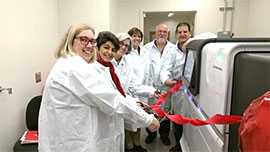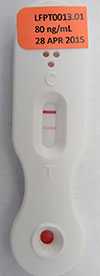Division of Bacterial Diseases (DBD) News Bulletin
Summer 2015
In This Issue
- Exploring Meningococcal Outbreaks & Carriage
- White House Forum on Antibiotic Stewardship
- New EIS Officers & LLS Fellow
- DBD Supports the Ebola Response
- MenAfriNet Partners Respond to Niger Outbreak
- Laboratory & Communications
- Vaccine News & Meetings
- Awards
- Epi-Aids & Outbreak Investigations
- Publication Highlights
Laboratory
PacBio Ribbon Cutting Ceremony
DBD unveiled its newest genetic sequencing system, the PacBio RS II, with a ribbon cutting on February 2, 2015. The PacBio provides highly accurate sequencing results, and can provide longer sequencing reads than other instruments currently available. The PacBio is being used in DBD’s many advanced molecular detection projects and will serve four primary laboratories within the division, including the sequencing of such bacteria as Bordetella pertussis, Legionella pneumophila, Neisseria meningitidis, Streptococcus pneumoniae, and many others.
External Laboratory Accreditation Underway in Microbial Pathogenesis and Immune Response Lab
The Microbial Pathogenesis and Immune Response (MPIR) Laboratory is undergoing an accreditation process through the American Association of Laboratory Accreditation. In response to recommendations made by the external Laboratory Safety Workgroup of the Advisory Committee to the Director, CDC, the MPIR Laboratory is seeking accreditation in the ISO 17025 standard. Laboratories that are accredited to this international quality standard have demonstrated that they are technically competent and able to produce precise and accurate test data. The MPIR Laboratory is one of five labs across CDC participating in the ISO 17025 pilot program.

Photo: Alison Mawle (NCIRD/OD), Rana Hajjeh (DBD/OD), Cyndy Whitney (DBD/RDB), Nancy Messonnier (NCIRD/OD), Leonard Mayer (DBD/OD), and Jonas Winchell (DBD/RDB) at the PacBio ribbon cutting ceremony on February 2, 2015.
Streptococcus Laboratory Provides Technical Support for Global Disease Detection Program in Kenya
Through a partnership with CDC’s Global Disease Detection Program, a five year study was conducted from 2009 to 2014 in Kibera and Lwak, Kenya to demonstrate the impact of the 10-valent pneumococcal conjugate vaccine (PCV10) on carriage of Streptococcus pneumoniae in children and adults. In order for the study to be successful, DBD’s Streptococcus Laboratory helped the Kenya bacteriology lab (KEMRII) by training over 10 staff members in pneumococcal isolation and serotyping in the field lab, hosting key Kenyan laboratory staff in Atlanta for in-depth training, and providing support with quality control and assurance. Together, DBD’s Streptococcus Laboratory and the KEMRII Laboratory analyzed 4,552 samples from study participants over the course of the study. Averaged across the study’s timeframe, the project team found that almost 9 out of every 10 children and 3 out of every 10 adults in the areas carry S. pneumoniae. Since the introduction of PCV10 in 2011, there has been a steady decline in the carriage of S. pneumoniae strains that are covered by the vaccine.
New Culture-Independent Diagnostic Tool in Development for Anthrax Disease
The MPIR Laboratory is developing a point of care lateral flow test targeting symptomatic inhalation anthrax. This test uses a finger prick of blood on a lateral flow immunoassay, similar to a pregnancy test, to detect Anthrax Lethal Factor (LF), the earliest biomarker that indicates infection. The test requires only 20 μL of blood to detect 10–20 ng/mL of LF, which is within the diagnostic range for inhalation anthrax.

Photo: Example of a positive test with the new MPIR lateral flow diagnostic tool used to test for inhalation anthrax infection.
Streptococcus Laboratory Co-leading the Global Pneumococcal Sequencing Project
With the Wellcome Trust Sanger Institute and Emory Global Health Institute, DBD’s Streptococcus Laboratory is leading the Global Pneumococcal Sequencing Project. The Sanger Institute is leading the whole genome sequencing of over 20,000 isolates of Streptococcus pneumoniae sequenced from across the globe. Approximately 2,000 strains of S. pneumoniae have been identified at the United States’ Active Bacterial Core surveillance program alone, with an additional 3,000 strains identified from the Global Strain Bank. The sequencing will help researchers better understand the evolution of S. pneumoniae, both regionally and globally, and identify genetic changes and adaptions that allow bacteria to avoid current vaccines or become resistant to antibiotics.
U.S. Patents Granted (9,046,520; 9,102,742): Serologic Correlates of Protection against Bacillus anthracis Infection
CDC inventors Vera Semenova (DBD/MVPDB), Conrad Quinn (DBD/MVPDB), Jan Pohl (NCEZID/DSR), and Pavel Svoboda (NCEZID/DSR) recently had two patents granted by the U.S. Patent Office. The patents will protect the intellectual property of unique sequences within the Protective Antigen (PA) protein toxin of Bacillus anthracis, the bacterium that causes anthrax disease. The inventors discovered that antibody responses to these regions of PA are correlated with vaccine induced protection against anthrax disease. They also discovered that antibodies raised against synthetic peptide versions of these sequences were able to neutralize anthrax lethal toxin in laboratory tests. The inventions improve understanding of vaccine induced correlates of protection. The discoveries may be used in developing synthetic peptide vaccines for anthrax.
Advanced Molecular Detection Updates
Historical Legionella Isolates Impacting Research Today
DBD’s Pneumonia Response and Surveillance Laboratory is using today’s advanced molecular detection technology to better understand Legionella pneumophila. The lab has cultivated historical samples from the 1970s that will be analyzed for comparison to the environmental and clinical strains that are circulating today. The sequencing data from these strains are being processed and analyzed through the newly developed bioinformatics pipeline and will be used to better understand the evolution of this bacterium and why some strains tend to cause more infection than others.
Automated Bioinformatics Pipeline Established for Streptococcus pneumoniae
DBD’s Streptococcus Laboratory has fully established and implemented its automated bioinformatics pipeline (ABP) for Streptococcus pneumoniae. The ABP can determine serotypes, antibiotic resistance, and genotypes based on over 1,500 pneumococcal isolates. So far, the ABP has characterized over 600 pneumococcal isolates that have caused invasive infections in 2015 and are projected to characterize over 3,000 isolates by the end of 2016. Pipelines for groups A and B Streptococcus are also being created and are expected to be functional by 2016.
Bacterial Meningitis Laboratory Receives Funding for New Project
DBD’s Bacterial Meningitis Laboratory was selected by the Office of Advanced Molecular Detection to receive funding for its new project, “Monitoring the Impact of Meningococcal and Hib Vaccines on Disease Burden Using Whole Genome Sequencing Based One-step Testing Scheme.” This project will transform bacterial meningitis surveillance by replacing the large number and combination of tests (PCR, Sanger sequencing, and PFGE) with an automated genomic analysis platform, currently in development. The platform will streamline the management of whole genome sequencing data and allow for the unambiguous identification and characterization of Neisseria meningitidis and Haemophilus influenzae, two of the three leading causes of bacterial meningitis, in just one step including classification, serogroup/serotype determination, antibiotic resistance detection, new strain detection, and strain genome comparison. This process will not only expand the knowledge on these bacteria, but also reduce costs and labor and improve overall efficiency and accuracy of laboratory diagnosis. This platform will be web-based and can easily be expanded to include other bacteria.
Bioinformatics Seminar Series Presentation on Pertussis
Stacey Martin and Michael Weigand participated in the Office of Advanced Molecular Detection’s Bioinformatics Seminar Series on April 30, 2015. Their presentation focused on the state of pertussis in the United States and DBD’s Pertussis and Diphtheria Laboratory’s use of advanced molecular detection (AMD) to better understand genomic changes that make circulating strains different from those current vaccines target. With whole genome sequencing and PacBio RS II sequencing technology, DBD’s Pertussis and Diphtheria Laboratory has actually found that pertussis is far more genetically diverse than once believed and that genetic changes are much more frequent than previously thought. This AMD-funded project continues to explore genome variation, using that data to help identify potential targets for future vaccines.
Communications

Image: New poster from the "Born with Protection against Whooping Cough" campaign.
Get Smart Website Is Mobile-friendly
DBD launched a newly designed Get Smart: Know When Antibiotics Work website in April. The website features new information for both consumers and clinicians in a format called responsive design. This allows users to view content on the new website in a way that is automatically optimized depending on the device used, including mobile phones, tablets, laptops, or widescreen computers.
New Website Highlights Impact of EPIC Study
A new CDC website dedicated to the Etiology of Pneumonia in the Community (EPIC) study was launched in February. The EPIC study was a prospective, multicenter, population-based, active surveillance study to monitor the burden of pneumonia, as well as its causes, in order to help guide policy and future treatment recommendations. The new website provides an overview of the study, a map of the sites where surveillance was conducted (3 pediatric hospitals and 5 adult hospitals), and a collection of publications that have resulted from the study.
New Campaign Promotes Maternal Tdap Vaccination
"Born with Protection against Whooping Cough," aims to increase awareness among pregnant women and healthcare providers that the whooping cough vaccine, Tdap, is recommended during the third trimester of every pregnancy. This recommendation helps protect babies from whooping cough during the first few months of life, when they are most vulnerable to serious disease and complications. Developed in collaboration with the American Academy of Family Physicians, American Academy of Pediatrics, American College of Nurse-Midwives, and the American College of Obstetricians and Gynecologists, the campaign includes a number of research-based resources for pregnant women (in English and Spanish) and healthcare professionals. Print materials can be ordered through CDC-Info on Demand.
- Page last reviewed: September 28, 2015
- Page last updated: September 28, 2015
- Content source:


 ShareCompartir
ShareCompartir